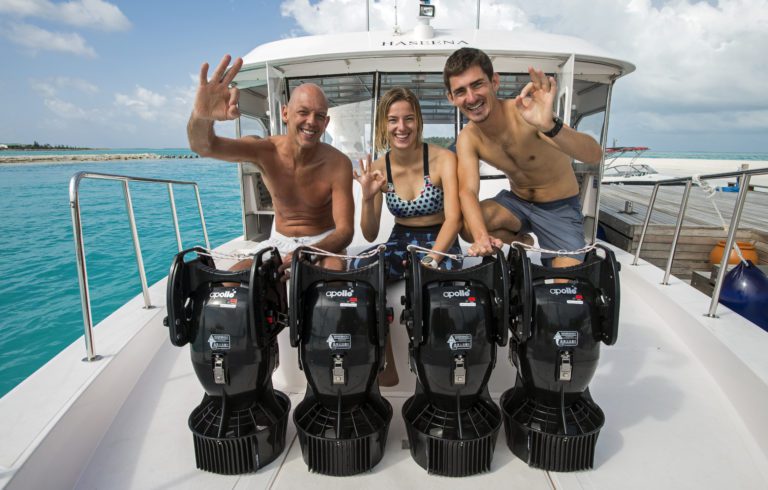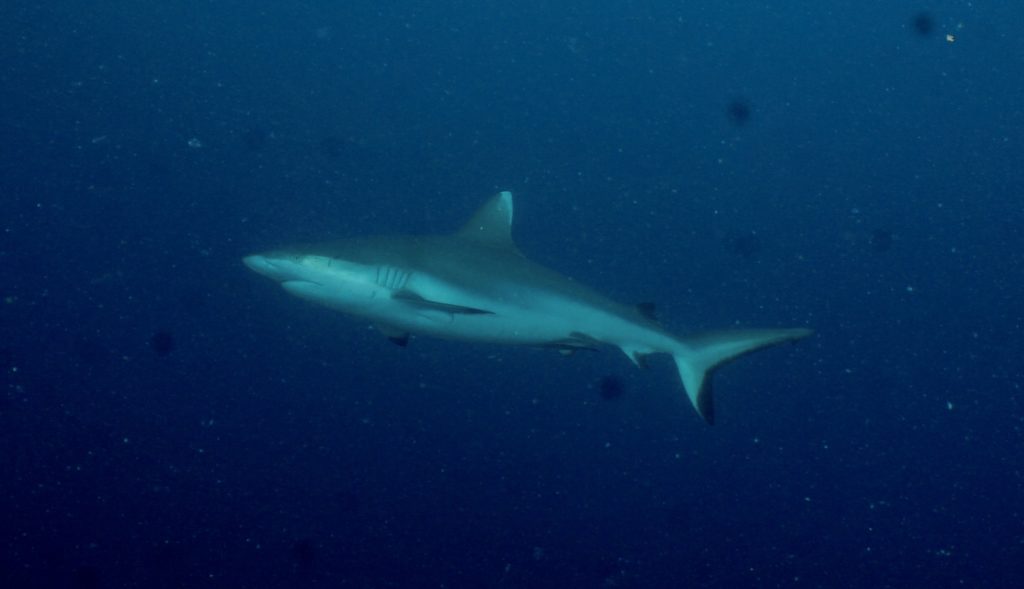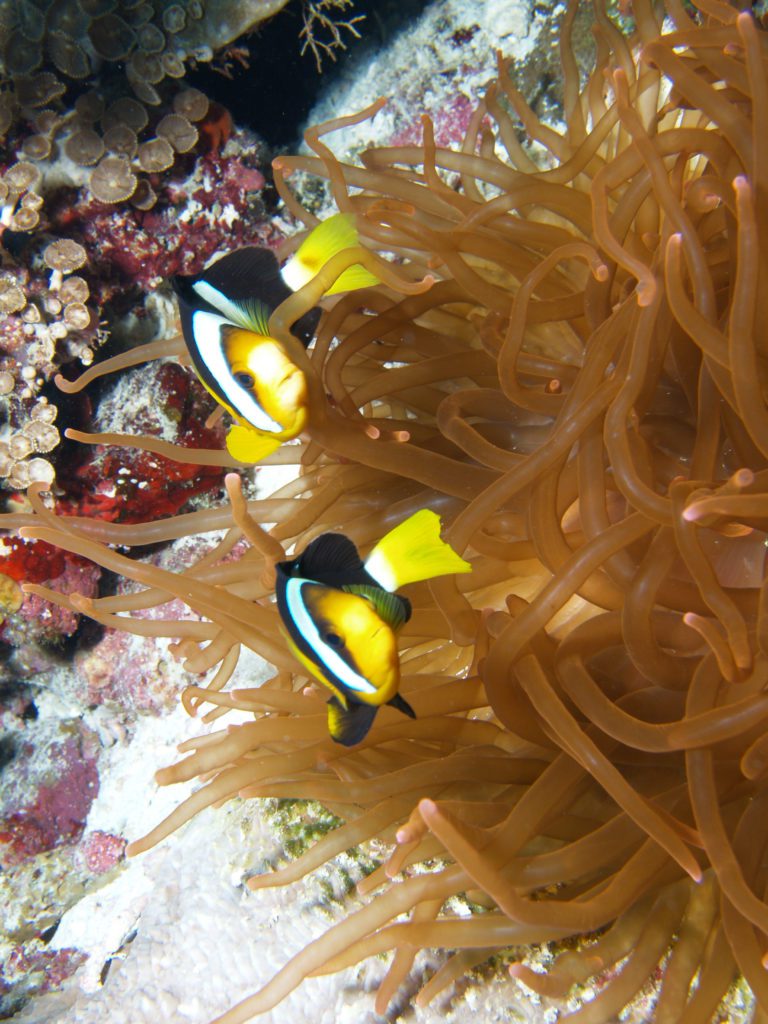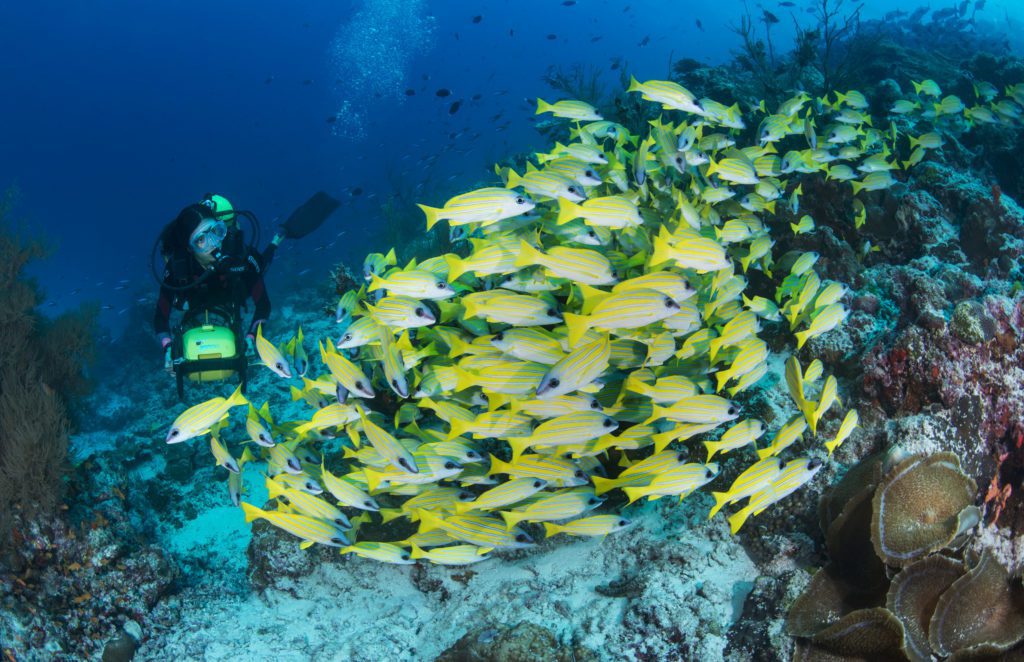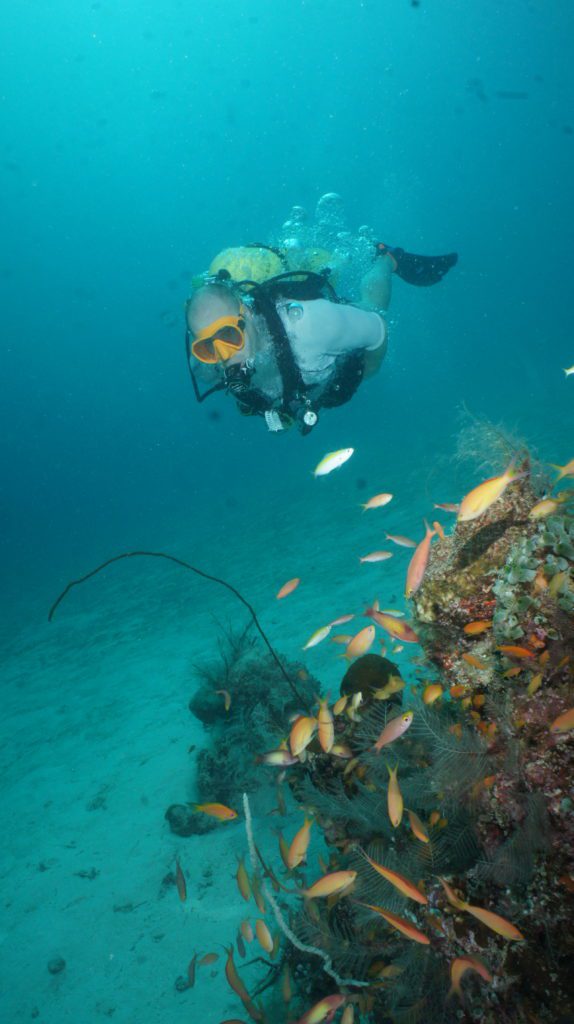‘I feel the need…the need – for speed!’ Channel dives are among the most exhilarating pastimes in the Maldives, but throw a scooter into the mix and you have all the ingredients for a massive amount of fun! MARK EVANS reports
The current was buffeting my mask and my bubbles were being ripped away from my exhaust as I breathed out. The hose on my primary second stage was undulating like a snake in a tornado, so I gripped my mouthpiece tighter between my teeth.
I was in the midst of a channel dive in the Maldives, the famed Kuredu Express site, and the blue water in front of me was full of swirling grey reef sharks effortlessly gliding on the currents flowing into the atoll. Below me, I could see the edge of the reef where it dropped away into the abyssal depths.
Out of the corner of my eye, I saw our guide Karola gesturing me to follow her along the reef, Tilting my shoulders slightly in her direction, the current pushed me sideways and then the power of the Apollo scooter nestled between my legs kicked in and I zoomed off, feeling like a pelagic predator as I swooped and dived in the blue.
I felt sorry for the other divers below who were current-hooked into the bottom of the channel and unable to move, especially when we blasted past them and swept down on a huge group of spotted eagle rays hanging in formation in the current. Combining scooters with channel-dives is a masterful move, but I had now been ruined forever – no channel-dive would ever compare again!
Get your motor running
The Maldives is world-renowned for its adrenaline-fuelled channel-dives. Its sometimes narrow channels funnel water flowing in and out of the atolls at quite phenomenal speeds, and this is a magnet for marine life, especially sharks, rays and the like.
The standard way to do a channel-dive is to drop into the water upcurrent of the entrance and drop down the wall as you drift towards the mouth. As the edge of the entrance comes into view, you fin like hell to get as close to the drop-off as possible, and then current-hook into the rocky bottom.
Once secured in position, you can inflate your BC and buffet around in the current like a kite in the wind and watch the endless parade of sharks, barracuda and other pelagics as they ride the currents in front of you. Once your bottom-time is up, you release your current-hook and zoom off on a drift-dive before being picked up by your dive-boat.
That is the ‘normal’ routine, but Prodivers on Kuredu decided to put its own spin on channel dives, and bring in Apollo AV2 Evolution scooters. Now riding a scooter brings another dimension to any dive, because you can cover so much more ground, while the simple act of being able to whizz around will put a huge smile on your face. However, add a scooter into the mix with Maldivian channel-diving and you’re on course for a memorable experience.
Riding on an Apollo
I have ridden various scooters and DPVs over the years, from small hand-held units like those from SeaDoo to clip-on beasts such as the Suex XK1, but I had never used an Apollo. These units are quite big and heavy compared with some of the newer scooters out there, but they have one unique quality that is what attracted Prodivers to them in the first place – with the addition of a plastic “saddle” on the front, you can sit and ride on them.
There are many advantages to this, not least the fact that it leaves your hands free to hold and operate your camera, but also it is far less tiring than controlling a scooter with your hands. It takes a little while to get used to “driving” one of these Apollos, but you soon get the gist of angling your body from your shoulders to steer left and right and go up and down.
Prospective scooter channel riders first have to go on a test drive on a normal reef dive to demonstrate that they can handle a scooter and have mastered the techniques required to fly one safely and proficiently. Don’t see this as a “wasted dive”, because zooming around on any dive on one of these scooters will leave you grinning like a Cheshire cat.
You attach the scooter to a D-ring on your BC with a short tether, so that if you stop and come off the saddle it doesn’t disappear into the depths, though it is only slightly negatively buoyant and, despite its size, easy to handle.
The controls are simplicity itself – you just reach down between your thighs and operate a lever. From the off position you can then set different speeds, from a gentle cruise to a full-on blast at top speed.
Once you have been signed off, you are able to head out for a channel- or drift-dive. We did a few of these through the course of our trip, but the one mentioned at the start of the article was the most memorable.
The incoming current was nice and strong, so we entered the water on the outside reef, clipped on our scooters, dropped to about 15m and then engaged power to fly along the reef in formation. As the reef-edge appeared in front of us, we switched up to full speed and headed out into the channel proper.
It’s mind-blowing flying around in the current ripping through the channel. Having been so accustomed to being anchored in one place on a current-hook, the level of freedom afforded by being on the scooter was incredible. We would motor along the edge of the drop-off and, when we came across some frenetic action, steer directly into the incoming current.
With the scooters on full power, we were able to just about hold position in the raging torrent, and it was amazing to be in the midst of the sharks as they glided around in the blue.
Once they moved on, or we tired of what we were seeing, we just leaned one way or the other and off we went to another location. On one occasion we dropped in on a huge shoal of spotted eagle rays, hanging in the current like a squadron of otherworldly spaceships. Another time we raced alongside a shoal of barracuda.
As our NDL approached, the real fun started. Karola signalled for us to turn and head into the channel, and as soon as we wheeled around and had the current behind us, we literally flew through the cut.
With the scooters on full speed and the flow with us, the underwater topography whipped by at a serious rate of knots. Now and again we would spot something of interest, pull a sharp 180° turn, allow the scooter’s power to hold us in position while we had a look, and then arc back round to resume our speed-drift. It was a truly high-speed way to round out an awesome channel-dive.
Apollo has been making underwater scooters since 1988, and the AV2 Evolution is the latest model. It features a runtime of up to 190 minutes per charge, is depth-rated to 70m, offers three speeds – up to a maximum of 2.8mph, which might not sound much but, believe me, feels rapid under water – and is made from sturdy ABS resin.
On the surface they are quite a lump, weighing in at around 21kg, but under water they are only negatively buoyant by a matter of a couple of pounds, so very easy to handle.
Prodivers since ‘88
Prodivers has been exploring the Maldives for 34 years, having opened the doors on Kuredu Resort & Spa back in 1988. Since then it has grown to become one of the biggest dive operations in the area, with centres on Hurawalhi, Innahura, Komandoo, Lily Beach and Vakarufalhi as well.
It can offer a wide range of courses, including entry-level and various specialities, as well as catering for snorkellers and those in search of topside watersports. It is also a PADI 5* IDC centre, and runs dive pros’ courses periodically through the year. If you fancy trying something new, it also offers closed-circuit rebreather try-dives.
There are more than 60 dive-sites accessible from Kuredu, so even if you’re on-island for an extended holiday, chances are that you could dive and never hit the same site twice although, believe me, iconic locations such as Kuredu Express and Kuredu Caves demand more than one visit.
Safety is paramount, says Prodivers, so all qualified nitrox divers use oxygen-enriched air free of charge on their dives and, in the unlikely event of a diving incident, it’s reassuring that there is a hyperbaric chamber and team of dive doctors right there on the island of Kuredu.
Photographs by Mark Evans
Also on Divernet: The Tiger Sharks Of Fuvahmulah, Scuba + Spa = Happy Days, Making A Difference In The Maldives, Batty As Frogfish On Bikes, A Match Made In The Maldives
